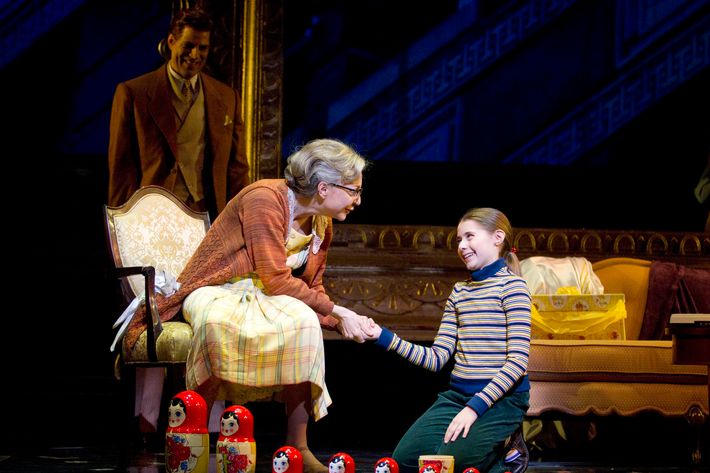

After several failed attempts, I’ve decided it’s impossible to review The People in the Picture, a new Holocaust musical from the author of Beaches and the composer of “Yakety Yak.” I can merely report that there is a new Holocaust musical from the author of Beaches and the composer of “Yakety Yak,” that is is now playing at Studio 54, and that it stars the great Donna Murphy. In the coming paragraphs, I will try to describe what it’s like, in descriptive and dispassionate language. But you should never forget—as, indeed, I will never forget —that what I’m describing is a Holocaust musical from the author of Beaches and the composer of “Yakety Yak.”
People is a memory musical, the brainchild of novelist-screenwriter (and now bookwriter-lyricist) Iris Rainer Dart —a woman renowned for not just jerking tears, but actually wringing the spent ducts dry. It tells the story of Raisel (Murphy), an aging survivor of the Warsaw Ghetto living in seventies New York with her harried daughter, Red (Nicole Parker), and precocious grandchild Jenny (Rachel Resheff). Jenny’s eager to learn about her Jewish heritage and her bubbe’s career on Europe’s Yiddish-theater circuit. Red, a harried, hyperassimilated TV writer, is less enthusiastic: She’s irked by her mother’s attachment to the past, and doesn’t want her daughter’s kopf polluted with a “backward” language and morbid Shoah stories. But the ghosts of Raisel’s past aren’t exorcised so easily, and they’re certainly helped along by her encroaching senility. (Toggling from old to young, flashback to here-and-now, with nothing but a couple of bad wigs and a pair of old-lady eyeglasses, Murphy deserves some sort of special citation for strength of character in the face of overwhelming theatrical adversity and absurdity.) In fact, these preternaturally happy-go-lucky spectres are always with her—literally—in the form of her old acting troupe, the Warsaw Gang (Broadway stalwarts Chip Zien and Joyce Van Patten among them). They’re kosher hams who crack wise in the face of genocide and yank Raisel back to prewar Poland, in reminiscence and, this being a musical, song.
Rock-and-roll legend Mike Stoller (“Smokey Joe’s Cafe,” “Jailhouse Rock,” and countless Brill Building hits) furnishes the tunes, teaming up with co-composer Artie Butler and contributor Mike Warshavsky to create a score that’s nine parts old-shul Klezmer to one part Fiddler-ized Klezmer; the ballads are the usual Broadway syrup. Dart herself supplied the lyrics. Some of her stylings are faux-naive, in the folk-theatrical tradition. (“Oy, oy, I am a dybbuk / I am a poor dybbuk / oy, oy, that’s why my feelings are hurt. / A dybbuk is never invited to parties / A dybbuk is treated like dirt.”) And some are simply leaden. (“Don’t look back there with longing / Your days with them are through. / You could have been murdered like children your age / Whose only transgression was being a Jew.”)
The oft-stated (and very familiar) theme of the night: Jews gotta laugh! Or else they’d plotz in this farkakt world of ours. And laugh they do: The Warsaw Gang yuks it up to the point of aggression, possibly even light insanity. They share some chortles with ashen-faced peasants who’ve just seen their families slain in pogroms. (“I remember he loved our shows!” is the first self-serving condolence out of Raisel’s mouth when a man informs her that his brother has been murdered.) They perform bits in the Ghetto, as human beings perish by the wagonload. One of their own number goes down in a hail of Nazi bullets—obligingly fired on the offbeats of a song called (I kid you not) “Ich, Uch, Feh.” (The bullets thunk rhythmically into his chest and belly between “feh” and “oy.”) Nothing, not even death, can stop the Gang’s indomitable mugging. This klatch of merry shoyshpilers is, depending on your point of view, either a triumph of the human spirit… or the most revoltingly delusional passel of narcissists this side of the Trump campaign.
But there I go, critiquing away, when I said I wouldn’t. It’s not my place to call The People in the Picture horrific Holo-kitsch that deserves quarantine in the same vault where The Day the Clown Cried and unsold DVDs of Jakob the Liar are sealed away. A couple of years ago, critics in London helped close down another Ghetto-set tuner called Imagine This!, the premise of which bore some striking similarities to People. Its producers pilloried the naysayers for their elitism—who are they to judge? When it comes to history’s great abominations, don’t we all own them, equally? Who says they’re off-limits to manipulative storytelling and tone-deafness? And it’s true: One person’s maudlin is, after all, another person’s poignant; one person’s tastelessness is another’s “bravery.” I can honestly say I felt anything but elite watching People; I felt like I was at home, in my underwear, watching Mystery Science Theater 3000 without the quippy commentary track. But that certainly wasn’t how the Wednesday-matinee crowd around me felt, and far be it from me to deny anyone his or her own culturally idiomatic version of a Tyler Perry hour-of-power. (Me, I’m a Waspy country-cracker: I cry at Alamo movies, Civil War melodramas, and anything where the dog dies.) I have no appropriate artistic or philosophical response to the evil of Nazism, and Dart, bending it to the rules of a Hollywood weepie, doesn’t either.
That said, there are really only two responses to a choreographed, in-rhythm genocide, and both responses are equally legitimate. I can honestly say: I laughed, I cried. And sometimes it was hard to tell the difference.




